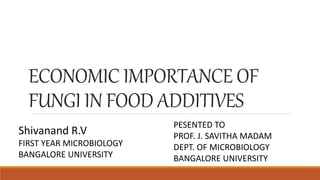
Economic Importance Of Fungi In Food Additives
- 1. ECONOMIC IMPORTANCE OF FUNGI IN FOOD ADDITIVES Shivanand R.V FIRST YEAR MICROBIOLOGY BANGALORE UNIVERSITY PESENTED TO PROF. J. SAVITHA MADAM DEPT. OF MICROBIOLOGY BANGALORE UNIVERSITY
- 2. INTRODUCTION Fungi have been widely used in the food industry for centuries, not only as food sources but also as sources of food additives. Food additives are substances that are added to food to improve its appearance, texture, taste, and shelf life. Fungi are used to produce various types of food additives, including enzymes, organic acids, flavors, and colorants, which have numerous economic benefits.
- 3. One of the most important types of food additives produced by fungi is enzymes. Fungi are capable of producing a wide variety of enzymes, which can be used in the food industry for various purposes. For example, the enzyme rennet, which is produced by the fungus Rhizomucor miehei, is widely used in cheese production to coagulate milk proteins and form curds. Other enzymes produced by fungi, such as amylases, lipases, and proteases, are used in food processing to improve the texture, flavor, and shelf life of food products.
- 4. Another important type of food additive produced by fungi is organic acids. Fungi such as Aspergillus and Penicillium are used to produce organic acids such as citric acid, lactic acid, and gluconic acid, which have numerous applications in the food industry. Citric acid, for example, is widely used as a flavor enhancer, preservative, and acidifier in various food products such as soft drinks, candies, and sauces.
- 5. Fungi are also used to produce flavors, which are used to enhance the taste and aroma of food products. Agaricus bisporus, for example, is a fungus that is widely used to produce mushroom flavor, which is used in a wide range of food products such as soups, sauces, and snacks. Similarly, Penicillium roqueforti is used to produce cheese flavor, which is used in various cheese products.
- 6. In addition to enzymes, organic acids, and flavors, fungi are also used to produce natural colorants. Monascus purpureus and Neurospora, for example, are fungi that are used to produce natural pigments such as red, yellow, and orange, which are used as food colorants. These pigments are widely used in various food products such as meat products, confectionery, and beverages.
- 7. Fungi Function in Food Additives Aspergillus oryzae Used to ferment soybeans in the production of soy sauce, miso, and sake Saccharomyces Used in baking as a leavening agent, and in brewing to ferment cerevisiae sugars into alcohol Rhizopus oryzae Used to ferment rice in the production of rice wine and vinegar Penicillium roquefortiUsed to produce blue cheese, including Roquefort, Stilton, and Gorgonzola Penicillium camemberti Used in the production of Camembert and Brie cheeses Candida rugosa Used as a flavor enhancer in some foods Fusarium venenatum Used to produce mycoprotein, a meat substitute
- 8. Classification Fungi Name Example Baker's yeast Saccharomyces cerevisiae Used in bread-making Quorn fungus Fusarium venenatum Used in vegetarian meat substitutes Enzyme producers Aspergillus oryzae, Aspergillus niger Used to produce enzymes for cheese and other dairy products Flavor enhancers Monascus purpureus Used in food coloring and to enhance flavor
- 9. Probiotics Lactobacillus, acidophilus, Bifidobacterium bifidum Uesd in diary products and dietery supplements Fermented products Penicillium roqueforti Used in the production of blue cheese Thickening agents Rhizopus oryzae Used to thicken soups and sauces
- 10. Classification Fungi Example Function colorants Monasus purpureus, Aspergillus oryzae Provide colour to foods, such as cheese sausage, and beverages Emulsifiers Rhizopus oligosporus, Aspergillus niger Help to blend ingredients that would not normally mix, such as oil and water, in order to create a stable, uniform product Flavor enahancers Saccharomyces cerevisiae, Aspergillus oryzae Improve the taste and aroma of food products, such as soups, sauces, and snack foods
- 11. Classification Examples Function Preservatives Penicillium roqueforti, Aspergillus flavus Prevent spoilage and extend the shelf life of food products by inhibiting the growth of microorganisms, such as bacteria and fungi Stabilizers and thickeners Xanthomonas campestris, Agaricus bisporus Improve the texture and consistency of food products, such as ice cream, salad dressings, and sauces
- 12. Classificatio n Examples Function Sweeteners Sccharomyces cerevisiae, Aspergillus oryaze Provide sweetness to food products without adding calories, such as in diet soft drinks and low-calorie desserts soft drinks and low-calorie desserts
- 13. Economic importance of fungi Fungi play an important role in the food industry as sources of food additives. Food additives are substances added to food to improve its taste, texture, appearance, and shelf life. Fungi are used to produce various food additives such as enzymes, organic acids, flavors, and colorants. Here are some examples of fungal food additives:
- 14. Enzymes: Fungi are used to produce enzymes such as amylases, lipases, and proteases, which are used in food processing to improve the texture, flavor, and shelf life of food. For example, the enzyme rennet, which is produced by the fungus Rhizomucor miehei, is used to coagulate milk in cheese production. Organic acids: Fungi such as Aspergillus and Penicillium are used to produce organic acids such as citric acid, lactic acid, and gluconic acid, which are used as flavor enhancers, preservatives, and acidifiers in food processing. Citric acid, for example, is used in soft drinks, candies, and sauces.
- 15. Flavors: Fungi are used to produce natural flavors such as mushroom flavor, which is produced by the fungus Agaricus bisporus, and cheese flavor, which is produced by the fungus Penicillium roqueforti. These flavors are used in a wide range of food products such as soups, sauces, and snacks. Colorants: Fungi such as Monascus purpureus and Neurospora are used to produce natural pigments such as red, yellow, and orange, which are used as food colorants. These pigments are used in a wide range of food products such as meat products, confectionery, and beverages.